The Nemean Lion and the Games
Reading time: 8 min
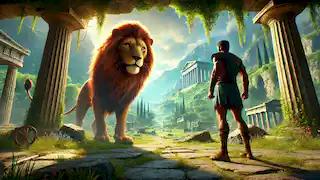
About this story: The Nemean Lion and the Games is a Myth from Greece set in the Ancient This Descriptive tale explores themes of Courage and is suitable for All Ages. It offers Cultural insights. A tale of Heracles' triumph over the Nemean Lion and the birth of the Nemean Games.
Introduction
In the heart of ancient Greece, where myths intertwined with reality, stood the region of Nemea, a place renowned for its fertile lands and ancient vineyards. Yet, it was not these natural bounties that Nemea was most famous for, but rather a legend that cast a shadow over the landscape—the legend of the Nemean Lion. This monstrous beast, said to be the offspring of Typhon and Echidna, possessed a hide impervious to all mortal weapons. It terrorized the countryside, leaving devastation in its wake and becoming a symbol of unconquerable fear.
The Nemean Lion's origin was steeped in divine myth. According to legend, the gods themselves played a role in the creation of this formidable creature. Hera, the queen of the gods, seeking to challenge the hero Heracles, placed the lion in the hills of Nemea. The creature's presence was a test, a trial for the hero whose destiny was to perform twelve labors as penance for past misdeeds. The lion's hide, impenetrable to swords, arrows, and spears, made it seem an invincible foe. Its mere roar could freeze the bravest warrior in his tracks, and its claws could tear through armor like parchment.
The people of Nemea, desperate and terrified, sought refuge in their fortified towns, but the lion's presence made even daily life a perilous endeavor. Livestock were slaughtered, and travelers disappeared without a trace. The once thriving trade routes became desolate as merchants avoided the region. It was under these dire circumstances that Heracles, son of Zeus and Alcmene, was tasked with his first labor: to kill the Nemean Lion and bring back its hide as proof of his triumph.
Heracles, known for his unparalleled strength and heroic deeds, was nonetheless aware of the magnitude of this task. As he traveled to Nemea, he met various locals who recounted their harrowing experiences with the lion. They spoke of its glowing eyes that pierced through the darkness and the terrifying silence that followed its roar. These tales, far from deterring Heracles, only steeled his resolve. He was determined to succeed, not only to prove his worth but also to rid the land of this fearsome beast.
Upon arriving in Nemea, Heracles sought out the lion's lair, a cave with two entrances situated in the rocky hills. He devised a strategy; realizing that conventional weapons were useless, he blocked one entrance of the cave with boulders. This left only one way for the lion to exit, forcing it into a confrontation. As Heracles waited, the lion emerged, and the hero confronted it with his bow and arrows. However, just as the legends foretold, the arrows bounced harmlessly off the lion's impenetrable hide.
Realizing the futility of his weapons, Heracles cast aside his bow and sword, preparing for a battle of strength. The ensuing struggle was a titanic clash of wills and power. Heracles, using his immense strength, grappled with the lion, avoiding its claws and fangs. The lion, in turn, used its agility and ferocity to try and overwhelm the hero. The fight seemed endless, each moment more desperate than the last. Finally, using all his might, Heracles managed to get behind the lion, locking his arms around its neck. With a powerful grip, he choked the life out of the beast.
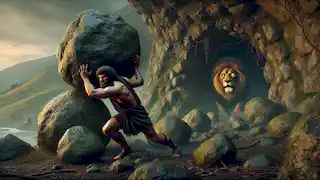
The death of the Nemean Lion was a monumental event. Heracles, bloodied but victorious, stood over the beast's lifeless body. However, his task was not yet complete. He needed to bring the lion's hide back to King Eurystheus as proof of his accomplishment. Yet, even in death, the lion's hide remained a formidable challenge. No blade could pierce it. It was then that Athena, the goddess of wisdom and war, appeared to Heracles. She guided him to use the lion's own claws, the only tools sharp enough, to skin the beast. Following her advice, Heracles succeeded in flaying the lion, fashioning its hide into a cloak and its head into a helmet, symbols of his victory and new armor against future perils.
Heracles returned to Mycenae, where King Eurystheus, both in awe and fear, saw the hide of the Nemean Lion. From that day forward, the lion's pelt became Heracles' iconic armor, symbolizing his triumph over an indomitable force. The people of Nemea rejoiced, free from the terror that had plagued them for so long. The story of Heracles' victory spread throughout Greece, becoming a symbol of the triumph of human courage and strength over seemingly insurmountable challenges.
The significance of Heracles' victory extended beyond the immediate relief it brought to Nemea. It inspired the creation of the Nemean Games, a series of athletic competitions held every two years in honor of Zeus, the king of the gods, and Heracles, the hero. These games included foot races, wrestling, and chariot races, drawing competitors from all over Greece. The Nemean Games were a celebration of physical prowess, but more importantly, they were a tribute to the virtues of courage, endurance, and honor that Heracles embodied.
The games were held in a sacred grove near the temple of Zeus, amidst ancient oak trees that were believed to be as old as the world itself. The athletes competed not for material prizes but for glory and the honor of being crowned with a wreath of wild celery, a symbol of victory and divine favor. The Nemean Games became a revered tradition, a time for the Greek city-states to set aside their differences and come together in celebration of their shared culture and values.
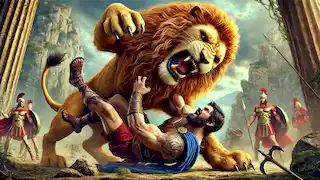
As the years passed, the legend of the Nemean Lion and Heracles' triumph became a cornerstone of Greek mythology. It was not merely a tale of a hero defeating a monster but a story that encapsulated the human condition—the struggle against overwhelming odds, the importance of intelligence and strength, and the enduring spirit of perseverance. The story was retold in countless variations, each emphasizing different aspects of Heracles' character and the moral lessons to be learned.
The Nemean Games, much like the story of Heracles, evolved over time. They became a venue for not only athletic competition but also for artistic and musical performances, celebrating the full spectrum of human achievement. Poets recited verses celebrating the deeds of heroes, musicians played hymns in honor of the gods, and philosophers engaged in debates about the nature of virtue and excellence. The games were a reflection of the Greek ideal of arete, the pursuit of excellence in all things.
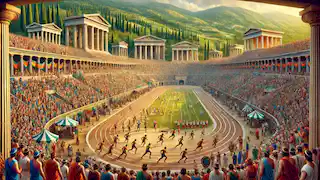
The enduring legacy of the Nemean Games and the legend of the Nemean Lion can be seen in the modern Olympic Games, which continue the ancient tradition of celebrating human athleticism and spirit. The Olympics, much like the Nemean Games, bring together people from around the world in a celebration of peace, competition, and the shared values of humanity. The stories of the ancient games, including that of the Nemean Lion, serve as a reminder of the timelessness of these values.
In conclusion, the story of "The Nemean Lion and the Games" is a rich tapestry of mythology, history, and cultural tradition. It tells of a hero who faced down a monstrous challenge, a community that celebrated his victory through athletic and cultural competition, and a legacy that continues to inspire and unite people across the globe. The tale of Heracles and the Nemean Lion is not just a story of the past; it is a living narrative that resonates with the eternal human desire to overcome adversity, to excel, and to be remembered for our deeds.
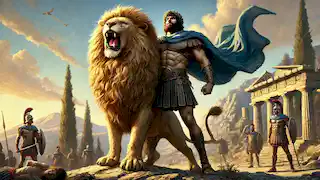
The Nemean Lion, once a creature of terror, now stands as a symbol of the challenges we all face in life and the potential for greatness within each of us. Whether through feats of strength, acts of courage, or the pursuit of excellence in any endeavor, the spirit of Heracles lives on. The Nemean Games, with their emphasis on honor, competition, and celebration, remind us of the importance of striving for greatness, not just for personal glory but for the betterment of all.
As we reflect on this timeless tale, we see that the true legacy of Heracles and the Nemean Lion lies not in the physical accomplishments alone, but in the inspiration they provide to future generations. The story is a testament to the power of myth to convey deeper truths about the human condition, to inspire us to reach beyond our limitations, and to celebrate the triumphs of the human spirit. The Nemean Lion, though a fearsome beast, ultimately becomes a part of a larger narrative about heroism, resilience, and the enduring quest for excellence.
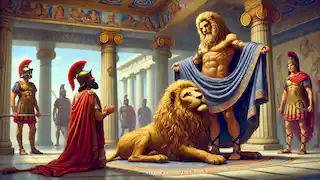
Thus, "The Nemean Lion and the Games" stands as a lasting testament to the power of stories to connect us to our past, to each other, and to the timeless values that define us as human beings. It is a story that will continue to be told, celebrated, and cherished, reminding us of the enduring power of courage, ingenuity, and the human spirit.


















